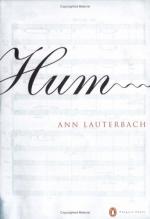|
This section contains 286 words (approx. 1 page at 400 words per page) |

|
Hum Summary & Study Guide Description
Hum Summary & Study Guide includes comprehensive information and analysis to help you understand the book. This study guide contains the following sections:
This detailed literature summary also contains Bibliography on Hum by Ann Lauterbach.
Hum is the title work of Ann Lauterbach's 2005 poetry collection published by Penguin. The poem is deceptively simple; it is composed of short lines, everyday words, and seemingly innocuous images of the sky and weather. Through its circuitous framework and tangible sense of bewilderment, however, Hum presents a visceral eyewitness reaction to the terrorist attacks on September 11, 2001, on the World Trade Center, in New York City, where Lauterbach then lived and worked.
The poem is composed of twenty-seven couplets, or two-line stanzas, full of repeated words and phrases. Beautiful, tomorrow, weep, weather, yesterday, and here are all echoed multiple times, giving the poem a tone of sorrow and a theme of temporal dislocation. Hum is written in free-verse style, meaning that its lines do not rhyme and do not have a consistent meter, or rhythm. In a postmodernist style, the images and phrases are fragmentary and often not meant to be taken literally. In a work such as this, the poet relies on the reader to fill in details based on his or her own experiences.
Lauterbach is often considered a member of the New York School of poets, a loose-knit group working primarily in Manhattan after 1950, whose work is influenced by the visual arts, especially abstract expressionism. This group includes such poets as John Ashbery, Barbara Guest, and James Schuyler, and their work is often as much about the process of writing as about the result. Like many abstract expressionist paintings, whose meanings can be difficult to decipher on the basis of their titles and images alone, Hum does not refer to the tragedy of the terrorist attacks directly, nor does it seek to explain or even mention the hum of the title.
Read more from the Study Guide
|
This section contains 286 words (approx. 1 page at 400 words per page) |

|



